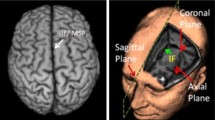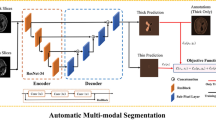Abstract
Generating surface shaded display images and measuring the volumes of cerebral ventricles using 3-D SPGR MR images will help to diagnose many types of cerebral diseases with quantitatively and qualitatively. However, manual segmentation of cerebral ventricles is time-consuming and is subject to inter- and intra-operator variation. This article proposes a fully automated method for segmenting cerebrospinal fluid (CSF) and cerebral ventricles from MR images. Our method segments the cerebral ventricles by using a representative line (RL), which can represent the abstract of the shape and position of the cerebral ventricles. The RL is found by fuzzy If-Then rules that can implement physicians’ knowledge on the cerebral ventricles. The proposed method was applied to MR volumes of 20 normal subjects, 20 Alzheimer disease (AD) and 20 normal pressure hydrocephalus (NPH) patients. The segmentation error ratio of the lateral ventricles was 1.98% in comparison with the volumes of manually delineated region by a physician. Using the proposed method, we found that patients of NPH significantly increased the ratio of volume of the lateral ventricles to the total CSF volume in comparison with that of AD (significance level < 0.001)
Similar content being viewed by others
References
Hakim S, Adams RD (1965) The special clinical problem of symptomatic hydrocephalus with normal cerebrospinal fluid pressure: observation on cerebrospinal fluid hydrodynamics. J Neurol Sci 2:303–327
Gammal T El, Allen MB Jr, Brooks BS, Mark EK (1987) MR evaluation of hydrocephalus. Am J Roentgenol 8:591–597
Worth AJ, Makris N, Patti MR, Hoge EA, Caviness VS Jr, Kennedy DN (1998) Precise segmentation of the lateral ventricles and caudate nucleus in MR brain images using anatomically driven histograms. IEEE Trans Med Imaging 17(2):303–310
Lundervold A, Storvik G (1995) Segmentation of brain parenchyma and cerebrospinal fluid in multispectral magnetic resonance images. IEEE Trans Med Imaging 14(2):339–349
Duta N, Sonka M (1998) Segmentation and interpretation of MR brain images: an improved active shape model. IEEE Trans Med Imaging 17(6):1049–1062
Reddick WE, Glass JO, Cook EN, Elkin TD, Deaton RJ (1997) Automated segmentation and classification of multispectral magnetic resonance images of brain using artificial neural networks. IEEE Trans Med Imaging 16(6):911–918
Yong F, Tianzi J, Evans, DJ (2002) Volumetric segmentation of brain images using parallel genetic algorithms. IEEE Trans Med Imaging 21(8):904–909
Kobashi S, Kondo K, Hata Y, Shibanuma N (2004) Volume visualization for functional assessments of the meniscus using multidetector CT images. In: Proceedings of the 6th Asian conference on computer vision 2:920–925
Kobashi S, Kondo K, Hata Y (2004) Target image enhancement using representative line in MR cholangiography images. Int J Imaging Syst Technol 14(3):122–130
Hata Y, Kobashi S, Hirano S, Kitagaki H, Mori E (2000) Automated segmentation of human brain mr images aided by fuzzy information granulation and fuzzy inference. IEEE Trans Syst Man Cybern. Part C 30(3):381–395
Kobashi S, Takae T, Kitamura YT, Hata Y, Yanagida T (2001) Fuzzy medical image processing for segmenting the lateral ventricles from MR images. In: Proceedings of IEEE 2001 International Conference on image processing, pp 1095–1098
Kobashi S, Kamiura N, Hata Y (1998) Fuzzy information granulation on segmentation of human brain MR images. J Japan Soc Fuzzy Theory Syst 10(1):117–125
Kitagaki H, Mori E, Ishii K, Yamaji S, Hirono N, Imamura T (1998) CSF spaces in idiopathic normal pressure hydrocephalus: morphology and volumetry. Am J Neuroradiol 19(7):1277–1284
Author information
Authors and Affiliations
Corresponding author
Rights and permissions
About this article
Cite this article
Kobashi, S., Kondo, K. & Hata, Y. Fully Automated Segmentation of Cerebral Ventricles from 3-D SPGR MR Images using Fuzzy Representative Line. Soft Comput 10, 1181–1191 (2006). https://doi.org/10.1007/s00500-005-0040-8
Published:
Issue Date:
DOI: https://doi.org/10.1007/s00500-005-0040-8




